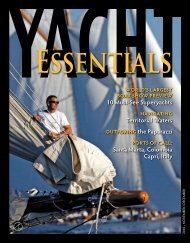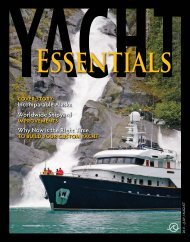photo contest - Yacht Essentials
photo contest - Yacht Essentials
photo contest - Yacht Essentials
Create successful ePaper yourself
Turn your PDF publications into a flip-book with our unique Google optimized e-Paper software.
PHOTO BY GLENN HAYES<br />
How to supply the electrical power required<br />
by yachts traveling to foreign ports can be a<br />
challenging problem. There are many issues<br />
to contend with, and a practical solution for<br />
ample and reliable electricity is more important than<br />
ever these days when one considers the array of new<br />
megayacht marinas opening the world over.<br />
Before plugging into shore power at a foreign port, there<br />
are several factors to consider. First are the voltage of the<br />
shore power and the line frequency. In the US, voltage<br />
is usually 120/240V AC with higher voltage available in<br />
some marinas for larger yachts. Voltage in other parts of<br />
the world may fall between 115V DC and 415V DC. The<br />
line frequency is the number of times the voltage alternates<br />
in a second and is measured in Hertz (Hz). In the<br />
US, this is 60Hz (or 60 cycles per second). In Europe and<br />
many other places overseas, it is 50Hz.<br />
Apart from the differences in voltage and line frequency,<br />
there’s also the issue of voltage fluctuations caused by<br />
the utility provider, by wiring and grounding issues, or by<br />
heavy load from other users along the dock. The other<br />
problem is how to connect to the shore power and what<br />
adapters are needed. There are many different connec-<br />
72 YACHT ESSENTIALS<br />
A PRACTICAL<br />
POWER SOLUTION<br />
Engineer’s Corner<br />
BY GLENN HAYES<br />
tors, and the well-prepared vessel will have a supply of<br />
various adapters on hand.<br />
One method to tame shore power issues is using onboard<br />
generators to supply voltage, and while this does solve the<br />
shore power issue, it has its drawbacks. There’s the cost of<br />
fuel and maintenance of running the generators. Wear and<br />
tear of the generator should be considered and is amplified<br />
if the generator is run at low output levels over extended<br />
periods. Generator noise is another issue at marinas and<br />
will not make your visit to the dock a popular one with vessels<br />
nearby. Many ports worldwide are in the process of requiring<br />
vessels to plug into shore power at berth to reduce<br />
emissions and comply with new, “greener” mandates, effectively<br />
banning generator use in port.<br />
Running on inverters with battery chargers re-supplying<br />
the energy is another option. This works fine if the energy<br />
draw isn’t too large and the chargers have enough<br />
capacity to recharge the batteries in off hours, but this is<br />
not always possible. If you use this option, it must also<br />
be understood that at 12 volts you will need between<br />
12 and 15 more amps for each amp of 120V AC used. If<br />
you have a 24V DC system, the amps required from an<br />
inverter would be about half of the 12V system. Larger














